Statistical Analysis of Gold Coast
VerifiedAdded on 2021/01/01
|7
|1589
|235
AI Summary
Contribute Materials
Your contribution can guide someone’s learning journey. Share your
documents today.
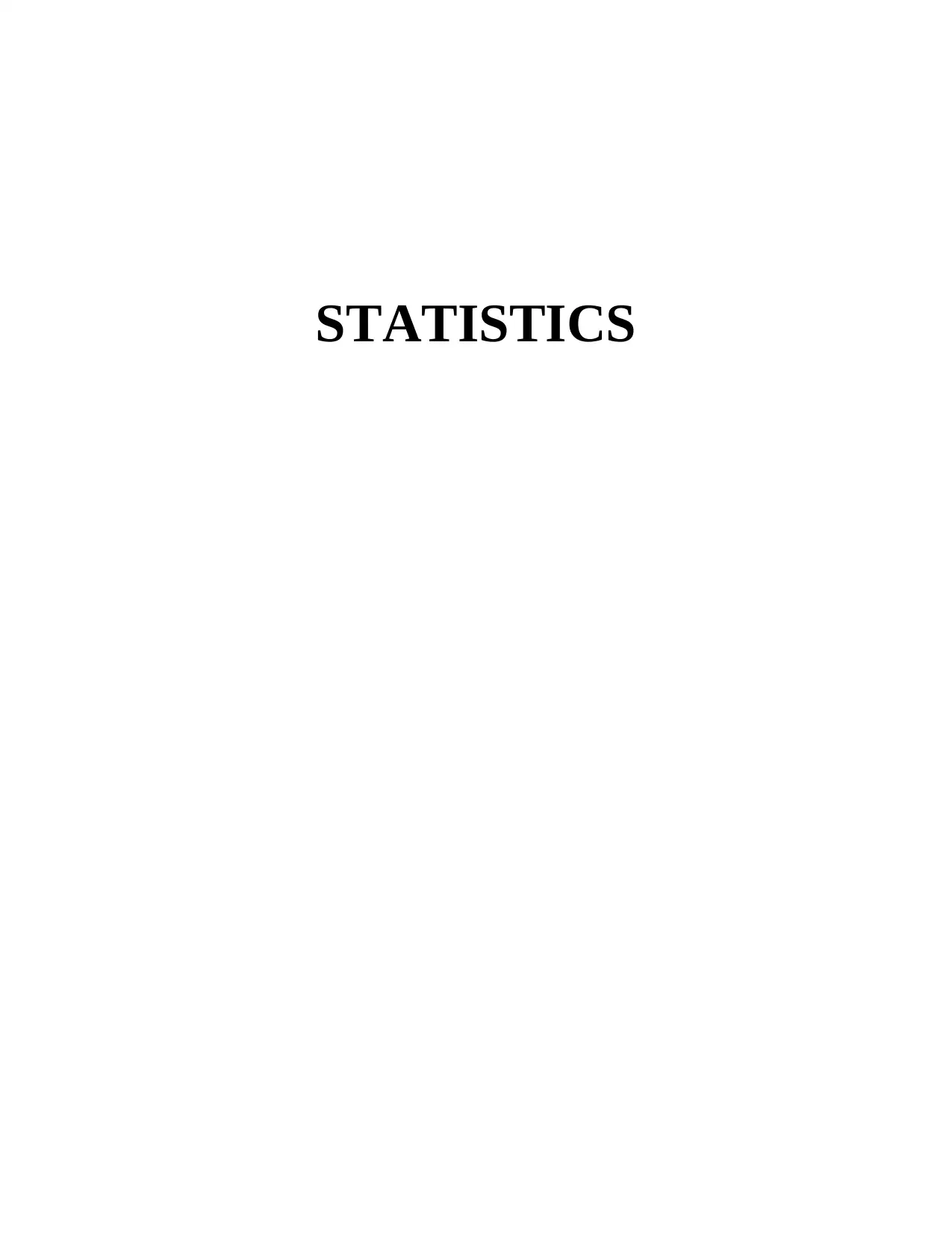
STATISTICS
Secure Best Marks with AI Grader
Need help grading? Try our AI Grader for instant feedback on your assignments.

Table of Contents
DATA..............................................................................................................................................1
METHODS......................................................................................................................................2
RESULTS........................................................................................................................................3
CONCLUIOSN................................................................................................................................4
DATA..............................................................................................................................................1
METHODS......................................................................................................................................2
RESULTS........................................................................................................................................3
CONCLUIOSN................................................................................................................................4
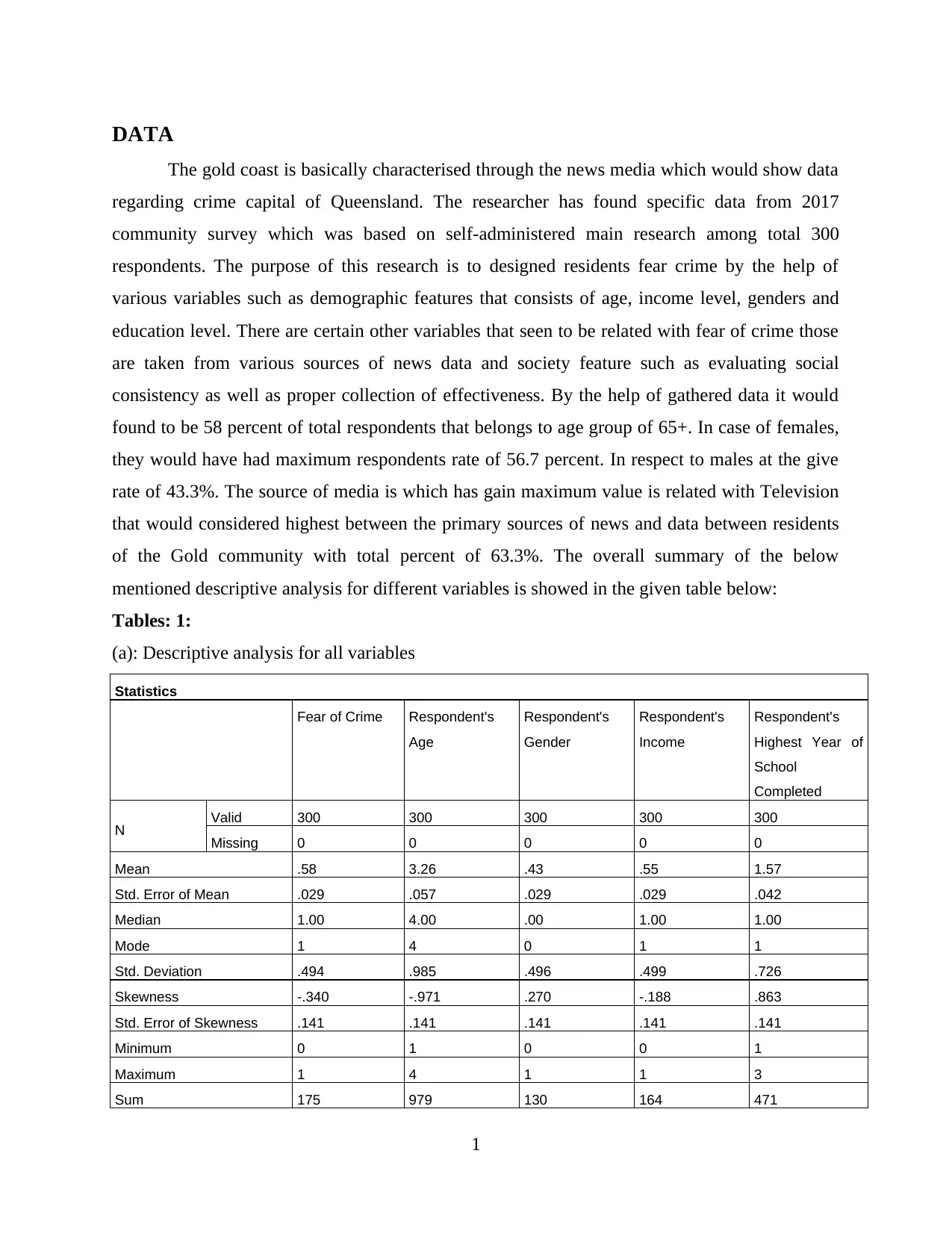
DATA
The gold coast is basically characterised through the news media which would show data
regarding crime capital of Queensland. The researcher has found specific data from 2017
community survey which was based on self-administered main research among total 300
respondents. The purpose of this research is to designed residents fear crime by the help of
various variables such as demographic features that consists of age, income level, genders and
education level. There are certain other variables that seen to be related with fear of crime those
are taken from various sources of news data and society feature such as evaluating social
consistency as well as proper collection of effectiveness. By the help of gathered data it would
found to be 58 percent of total respondents that belongs to age group of 65+. In case of females,
they would have had maximum respondents rate of 56.7 percent. In respect to males at the give
rate of 43.3%. The source of media is which has gain maximum value is related with Television
that would considered highest between the primary sources of news and data between residents
of the Gold community with total percent of 63.3%. The overall summary of the below
mentioned descriptive analysis for different variables is showed in the given table below:
Tables: 1:
(a): Descriptive analysis for all variables
Statistics
Fear of Crime Respondent's
Age
Respondent's
Gender
Respondent's
Income
Respondent's
Highest Year of
School
Completed
N Valid 300 300 300 300 300
Missing 0 0 0 0 0
Mean .58 3.26 .43 .55 1.57
Std. Error of Mean .029 .057 .029 .029 .042
Median 1.00 4.00 .00 1.00 1.00
Mode 1 4 0 1 1
Std. Deviation .494 .985 .496 .499 .726
Skewness -.340 -.971 .270 -.188 .863
Std. Error of Skewness .141 .141 .141 .141 .141
Minimum 0 1 0 0 1
Maximum 1 4 1 1 3
Sum 175 979 130 164 471
1
The gold coast is basically characterised through the news media which would show data
regarding crime capital of Queensland. The researcher has found specific data from 2017
community survey which was based on self-administered main research among total 300
respondents. The purpose of this research is to designed residents fear crime by the help of
various variables such as demographic features that consists of age, income level, genders and
education level. There are certain other variables that seen to be related with fear of crime those
are taken from various sources of news data and society feature such as evaluating social
consistency as well as proper collection of effectiveness. By the help of gathered data it would
found to be 58 percent of total respondents that belongs to age group of 65+. In case of females,
they would have had maximum respondents rate of 56.7 percent. In respect to males at the give
rate of 43.3%. The source of media is which has gain maximum value is related with Television
that would considered highest between the primary sources of news and data between residents
of the Gold community with total percent of 63.3%. The overall summary of the below
mentioned descriptive analysis for different variables is showed in the given table below:
Tables: 1:
(a): Descriptive analysis for all variables
Statistics
Fear of Crime Respondent's
Age
Respondent's
Gender
Respondent's
Income
Respondent's
Highest Year of
School
Completed
N Valid 300 300 300 300 300
Missing 0 0 0 0 0
Mean .58 3.26 .43 .55 1.57
Std. Error of Mean .029 .057 .029 .029 .042
Median 1.00 4.00 .00 1.00 1.00
Mode 1 4 0 1 1
Std. Deviation .494 .985 .496 .499 .726
Skewness -.340 -.971 .270 -.188 .863
Std. Error of Skewness .141 .141 .141 .141 .141
Minimum 0 1 0 0 1
Maximum 1 4 1 1 3
Sum 175 979 130 164 471
1
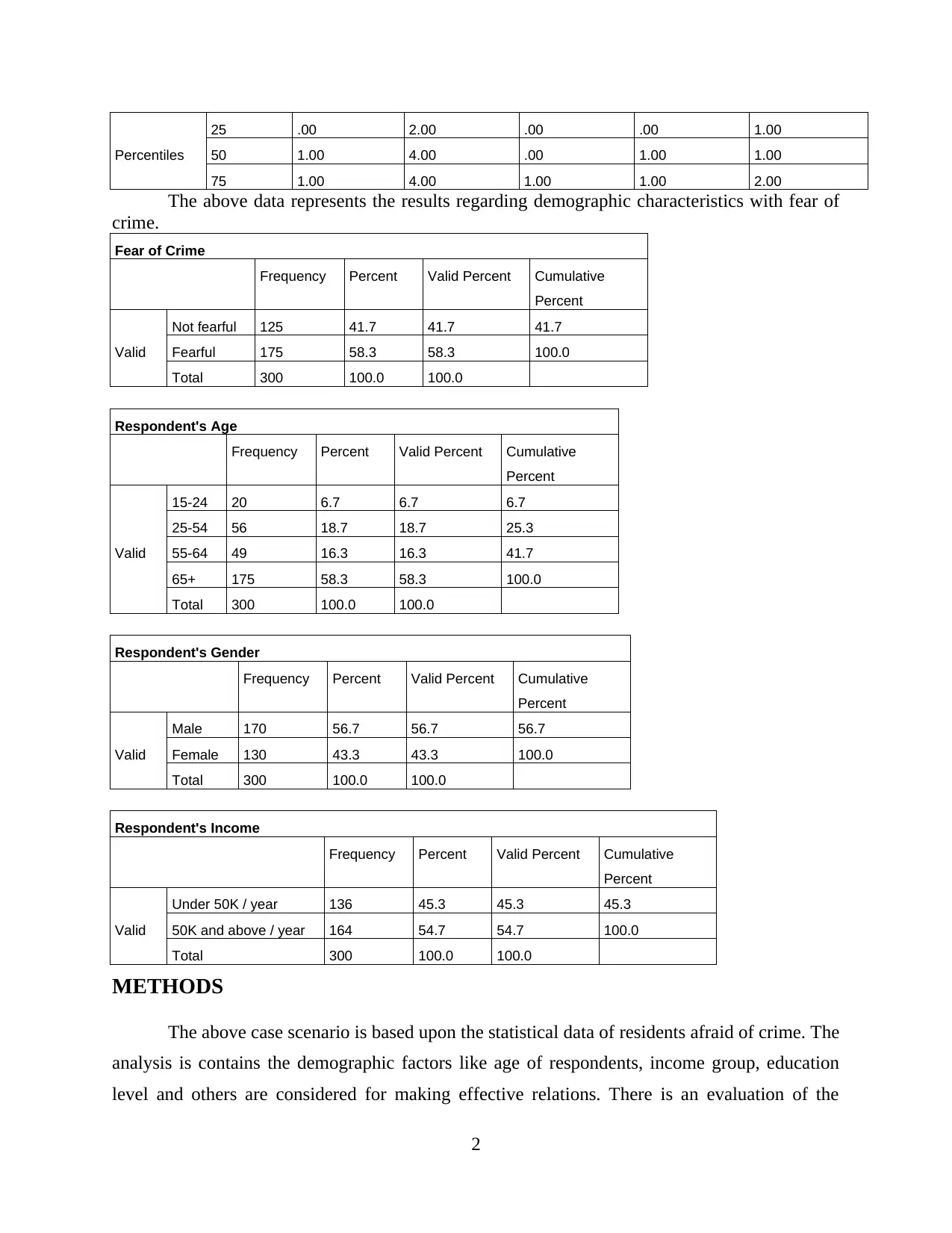
Percentiles
25 .00 2.00 .00 .00 1.00
50 1.00 4.00 .00 1.00 1.00
75 1.00 4.00 1.00 1.00 2.00
The above data represents the results regarding demographic characteristics with fear of
crime.
Fear of Crime
Frequency Percent Valid Percent Cumulative
Percent
Valid
Not fearful 125 41.7 41.7 41.7
Fearful 175 58.3 58.3 100.0
Total 300 100.0 100.0
Respondent's Age
Frequency Percent Valid Percent Cumulative
Percent
Valid
15-24 20 6.7 6.7 6.7
25-54 56 18.7 18.7 25.3
55-64 49 16.3 16.3 41.7
65+ 175 58.3 58.3 100.0
Total 300 100.0 100.0
Respondent's Gender
Frequency Percent Valid Percent Cumulative
Percent
Valid
Male 170 56.7 56.7 56.7
Female 130 43.3 43.3 100.0
Total 300 100.0 100.0
Respondent's Income
Frequency Percent Valid Percent Cumulative
Percent
Valid
Under 50K / year 136 45.3 45.3 45.3
50K and above / year 164 54.7 54.7 100.0
Total 300 100.0 100.0
METHODS
The above case scenario is based upon the statistical data of residents afraid of crime. The
analysis is contains the demographic factors like age of respondents, income group, education
level and others are considered for making effective relations. There is an evaluation of the
2
25 .00 2.00 .00 .00 1.00
50 1.00 4.00 .00 1.00 1.00
75 1.00 4.00 1.00 1.00 2.00
The above data represents the results regarding demographic characteristics with fear of
crime.
Fear of Crime
Frequency Percent Valid Percent Cumulative
Percent
Valid
Not fearful 125 41.7 41.7 41.7
Fearful 175 58.3 58.3 100.0
Total 300 100.0 100.0
Respondent's Age
Frequency Percent Valid Percent Cumulative
Percent
Valid
15-24 20 6.7 6.7 6.7
25-54 56 18.7 18.7 25.3
55-64 49 16.3 16.3 41.7
65+ 175 58.3 58.3 100.0
Total 300 100.0 100.0
Respondent's Gender
Frequency Percent Valid Percent Cumulative
Percent
Valid
Male 170 56.7 56.7 56.7
Female 130 43.3 43.3 100.0
Total 300 100.0 100.0
Respondent's Income
Frequency Percent Valid Percent Cumulative
Percent
Valid
Under 50K / year 136 45.3 45.3 45.3
50K and above / year 164 54.7 54.7 100.0
Total 300 100.0 100.0
METHODS
The above case scenario is based upon the statistical data of residents afraid of crime. The
analysis is contains the demographic factors like age of respondents, income group, education
level and others are considered for making effective relations. There is an evaluation of the
2
Secure Best Marks with AI Grader
Need help grading? Try our AI Grader for instant feedback on your assignments.
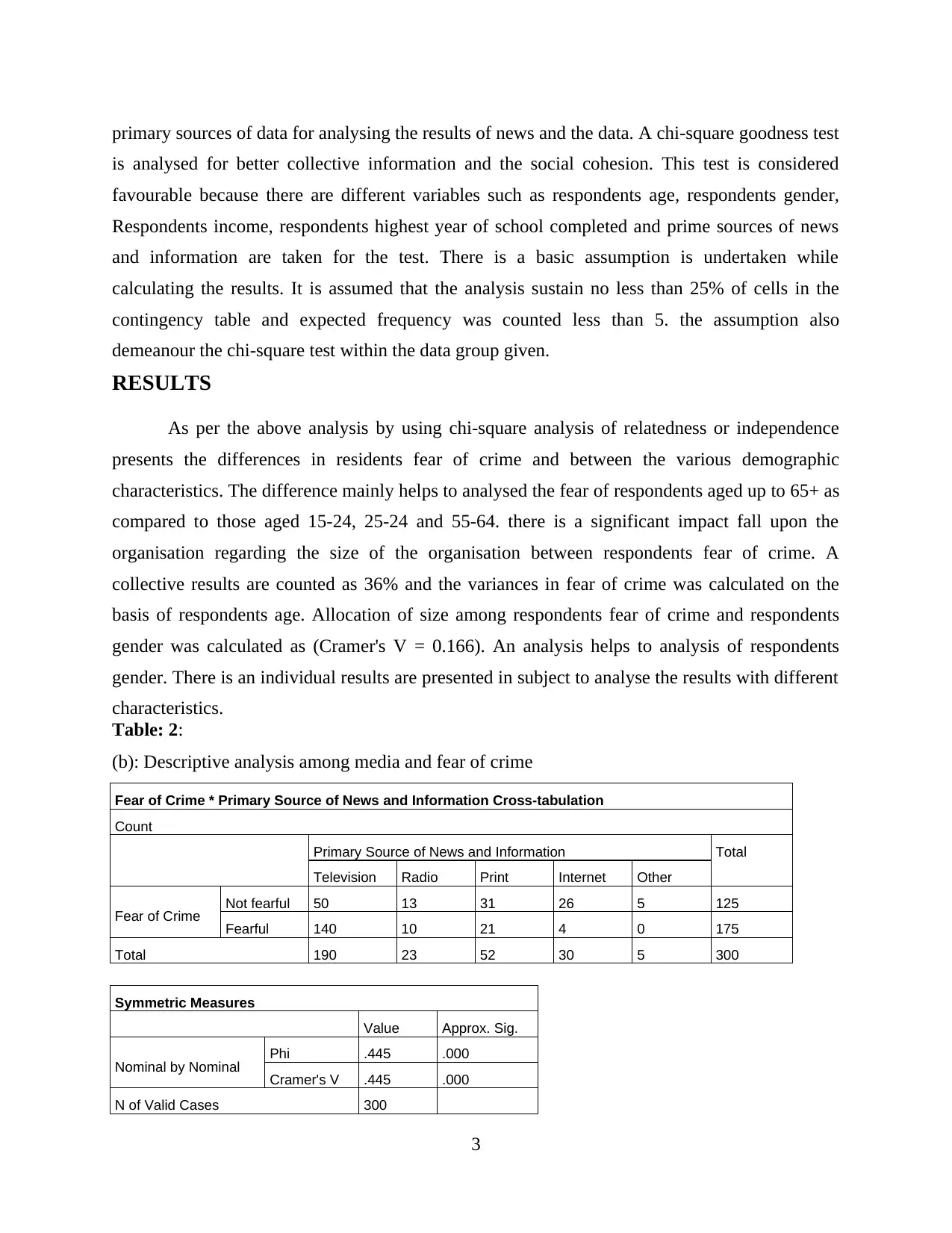
primary sources of data for analysing the results of news and the data. A chi-square goodness test
is analysed for better collective information and the social cohesion. This test is considered
favourable because there are different variables such as respondents age, respondents gender,
Respondents income, respondents highest year of school completed and prime sources of news
and information are taken for the test. There is a basic assumption is undertaken while
calculating the results. It is assumed that the analysis sustain no less than 25% of cells in the
contingency table and expected frequency was counted less than 5. the assumption also
demeanour the chi-square test within the data group given.
RESULTS
As per the above analysis by using chi-square analysis of relatedness or independence
presents the differences in residents fear of crime and between the various demographic
characteristics. The difference mainly helps to analysed the fear of respondents aged up to 65+ as
compared to those aged 15-24, 25-24 and 55-64. there is a significant impact fall upon the
organisation regarding the size of the organisation between respondents fear of crime. A
collective results are counted as 36% and the variances in fear of crime was calculated on the
basis of respondents age. Allocation of size among respondents fear of crime and respondents
gender was calculated as (Cramer's V = 0.166). An analysis helps to analysis of respondents
gender. There is an individual results are presented in subject to analyse the results with different
characteristics.
Table: 2:
(b): Descriptive analysis among media and fear of crime
Fear of Crime * Primary Source of News and Information Cross-tabulation
Count
Primary Source of News and Information Total
Television Radio Print Internet Other
Fear of Crime Not fearful 50 13 31 26 5 125
Fearful 140 10 21 4 0 175
Total 190 23 52 30 5 300
Symmetric Measures
Value Approx. Sig.
Nominal by Nominal Phi .445 .000
Cramer's V .445 .000
N of Valid Cases 300
3
is analysed for better collective information and the social cohesion. This test is considered
favourable because there are different variables such as respondents age, respondents gender,
Respondents income, respondents highest year of school completed and prime sources of news
and information are taken for the test. There is a basic assumption is undertaken while
calculating the results. It is assumed that the analysis sustain no less than 25% of cells in the
contingency table and expected frequency was counted less than 5. the assumption also
demeanour the chi-square test within the data group given.
RESULTS
As per the above analysis by using chi-square analysis of relatedness or independence
presents the differences in residents fear of crime and between the various demographic
characteristics. The difference mainly helps to analysed the fear of respondents aged up to 65+ as
compared to those aged 15-24, 25-24 and 55-64. there is a significant impact fall upon the
organisation regarding the size of the organisation between respondents fear of crime. A
collective results are counted as 36% and the variances in fear of crime was calculated on the
basis of respondents age. Allocation of size among respondents fear of crime and respondents
gender was calculated as (Cramer's V = 0.166). An analysis helps to analysis of respondents
gender. There is an individual results are presented in subject to analyse the results with different
characteristics.
Table: 2:
(b): Descriptive analysis among media and fear of crime
Fear of Crime * Primary Source of News and Information Cross-tabulation
Count
Primary Source of News and Information Total
Television Radio Print Internet Other
Fear of Crime Not fearful 50 13 31 26 5 125
Fearful 140 10 21 4 0 175
Total 190 23 52 30 5 300
Symmetric Measures
Value Approx. Sig.
Nominal by Nominal Phi .445 .000
Cramer's V .445 .000
N of Valid Cases 300
3
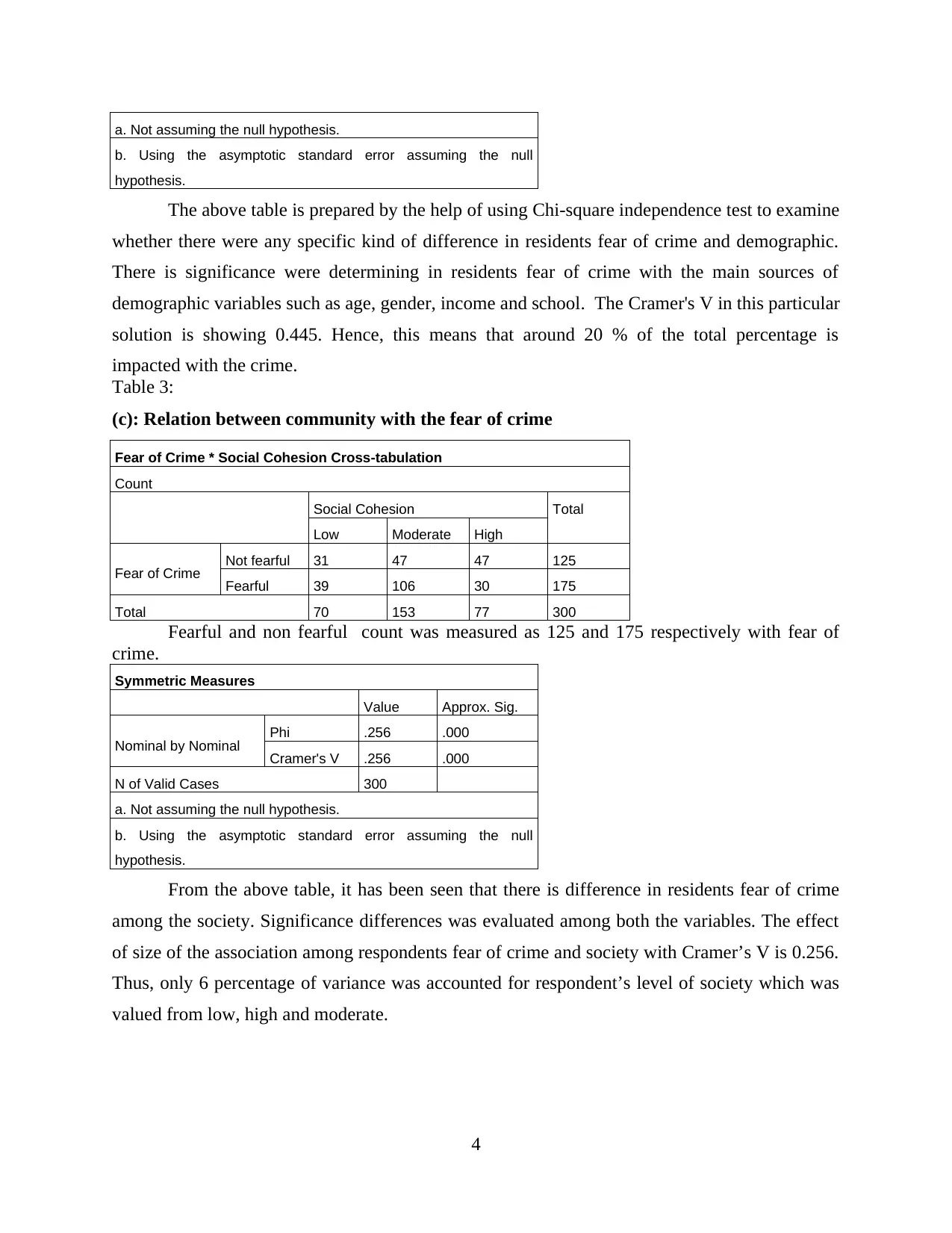
a. Not assuming the null hypothesis.
b. Using the asymptotic standard error assuming the null
hypothesis.
The above table is prepared by the help of using Chi-square independence test to examine
whether there were any specific kind of difference in residents fear of crime and demographic.
There is significance were determining in residents fear of crime with the main sources of
demographic variables such as age, gender, income and school. The Cramer's V in this particular
solution is showing 0.445. Hence, this means that around 20 % of the total percentage is
impacted with the crime.
Table 3:
(c): Relation between community with the fear of crime
Fear of Crime * Social Cohesion Cross-tabulation
Count
Social Cohesion Total
Low Moderate High
Fear of Crime Not fearful 31 47 47 125
Fearful 39 106 30 175
Total 70 153 77 300
Fearful and non fearful count was measured as 125 and 175 respectively with fear of
crime.
Symmetric Measures
Value Approx. Sig.
Nominal by Nominal Phi .256 .000
Cramer's V .256 .000
N of Valid Cases 300
a. Not assuming the null hypothesis.
b. Using the asymptotic standard error assuming the null
hypothesis.
From the above table, it has been seen that there is difference in residents fear of crime
among the society. Significance differences was evaluated among both the variables. The effect
of size of the association among respondents fear of crime and society with Cramer’s V is 0.256.
Thus, only 6 percentage of variance was accounted for respondent’s level of society which was
valued from low, high and moderate.
4
b. Using the asymptotic standard error assuming the null
hypothesis.
The above table is prepared by the help of using Chi-square independence test to examine
whether there were any specific kind of difference in residents fear of crime and demographic.
There is significance were determining in residents fear of crime with the main sources of
demographic variables such as age, gender, income and school. The Cramer's V in this particular
solution is showing 0.445. Hence, this means that around 20 % of the total percentage is
impacted with the crime.
Table 3:
(c): Relation between community with the fear of crime
Fear of Crime * Social Cohesion Cross-tabulation
Count
Social Cohesion Total
Low Moderate High
Fear of Crime Not fearful 31 47 47 125
Fearful 39 106 30 175
Total 70 153 77 300
Fearful and non fearful count was measured as 125 and 175 respectively with fear of
crime.
Symmetric Measures
Value Approx. Sig.
Nominal by Nominal Phi .256 .000
Cramer's V .256 .000
N of Valid Cases 300
a. Not assuming the null hypothesis.
b. Using the asymptotic standard error assuming the null
hypothesis.
From the above table, it has been seen that there is difference in residents fear of crime
among the society. Significance differences was evaluated among both the variables. The effect
of size of the association among respondents fear of crime and society with Cramer’s V is 0.256.
Thus, only 6 percentage of variance was accounted for respondent’s level of society which was
valued from low, high and moderate.
4

CONCLUIOSN
The above mentioned report summaries the statistical analysis of Gold Coast Community
Survey 2017. Analysis was mainly based upon the self managed mail survey presented in various
levels of fear of crime and assessing the demographic characteristics, information and
community characteristics. Criteria of respondents was as follows aged 65+ counted as more
fearful of crime (82.3%). Age 25-54 (8%). three research questions are summarized as
demographic characteristics of community residents related to fear and crime separately are
calculated separately. Third question is analyzed on the basis of characteristics related to
resident's fear of crime. As There are highly detailed analysis was analyses with falling of
victims. Second question analyses that the media and context was mainly analyzed with various
news stations. It is required to analyses the current crimes and the rates for better control and
management. The respondents must be motivated for more community activities to increase the
relationship among communities. This is the main reason that social cohesion was counted at
high as apposed to moderate or low.
5
The above mentioned report summaries the statistical analysis of Gold Coast Community
Survey 2017. Analysis was mainly based upon the self managed mail survey presented in various
levels of fear of crime and assessing the demographic characteristics, information and
community characteristics. Criteria of respondents was as follows aged 65+ counted as more
fearful of crime (82.3%). Age 25-54 (8%). three research questions are summarized as
demographic characteristics of community residents related to fear and crime separately are
calculated separately. Third question is analyzed on the basis of characteristics related to
resident's fear of crime. As There are highly detailed analysis was analyses with falling of
victims. Second question analyses that the media and context was mainly analyzed with various
news stations. It is required to analyses the current crimes and the rates for better control and
management. The respondents must be motivated for more community activities to increase the
relationship among communities. This is the main reason that social cohesion was counted at
high as apposed to moderate or low.
5
1 out of 7
Your All-in-One AI-Powered Toolkit for Academic Success.
+13062052269
info@desklib.com
Available 24*7 on WhatsApp / Email
![[object Object]](/_next/static/media/star-bottom.7253800d.svg)
Unlock your academic potential
© 2024 | Zucol Services PVT LTD | All rights reserved.


